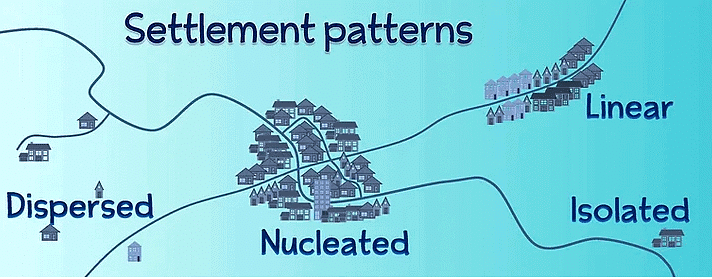Class 10 Exam > Class 10 Notes > Geography for GCSE/IGCSE > Patterns of Settlement
Patterns of Settlement | Geography for GCSE/IGCSE - Class 10 PDF Download
Categorising settlements
- A settlement refers to a location where individuals reside and engage in various activities like trade, manufacturing, and agriculture.
- These settlements can be classified based on their arrangement patterns.
- However, there are additional elements that impact settlements, including:
- Shape or configuration
- Location and surroundings
- Purpose and organizational structure
- Evolution and expansion - Contemporary settlement configurations are undergoing transformations due to shifts in population dynamics, technological advancements, evolving lifestyles, and the expansion of urban boundaries, leading to the emergence of megacities and urban sprawl.
Pattern
- Settlements vary in their shapes and sizes, referred to as patterns, which can range from solitary structures in rural locales to sprawling urban megacities with populations exceeding 10 million.
- Urban centers like towns, cities, conurbations, and megacities tend to have high population densities within a compact area.
- In contrast, rural towns and outskirts typically exhibit higher population densities spread across a larger expanse.
- Villages and hamlets generally feature lower population densities and smaller settled areas.
- The geographical features of an area determine these settlement patterns.
Question for Patterns of SettlementTry yourself: How can settlements be categorized based on their arrangement patterns?View Solution
Settlement Patterns
- Settlement patterns refer to the way in which human settlements are arranged or laid out.
- Settlement patterns can take various forms based on different factors such as geographical features, transportation routes, and historical development.
- These patterns play a crucial role in shaping the social interactions, accessibility, and overall functionality of a community.
Linear Settlements
- Linear settlements are characterized by a development pattern that follows a linear feature such as a river, railway, or major road.
- For example, a town developing along a river might have a linear shape to facilitate trade and transportation.
Circular Settlements
- Circular settlements typically form around a central point or feature, such as a village green or a lake.
- These settlements are often organized in a circular or radial manner, with the central area remaining accessible to the residents.
Star-Shaped Settlements
- Star-shaped settlements occur when multiple roads converge at a central point, and buildings are constructed along these roads.
- Such settlements often have a distinctive star-like layout when viewed from above.
T-Form Settlements
- T-form settlements are formed when one road meets another road at a junction, creating a T-shaped layout of buildings and infrastructure.
- These settlements often exhibit a linear extension along one axis, with development branching off from the junction.
Y-Form Settlements
- Y-form settlements emerge at the intersection of two roads, leading to the construction of buildings along these intersecting routes.
- Such settlements may feature a Y-shaped pattern of development, with structures aligned along the roadways.
Cruciform Settlements
- Cruciform settlements are characterized by a cross-shaped layout, typically found at crossroads where houses cluster and spread in all four directions.
- These settlements often have a nucleated pattern of development, with buildings radiating outward from a central point.
Cross-Shaped Settlements
- Cross-shaped settlements resemble cruciform layouts but with a distinct difference - the houses are arranged linearly around the crossroads rather than clustered.
- This layout can create a unique visual pattern in the settlement design, emphasizing the crossroad as a central point of reference.

Dispersed
- Dispersed settlements are characterized by isolated houses or farms spread out in fields or along roads, rather than concentrated in one central area.
- Examples of dispersed settlements can be found in sparsely populated rural regions like the Sahel region of Africa, the Australian outback, or the mountainous areas of Scotland and Wales.
- In England during the 16th and 17th centuries, the breakup of large rural estates led to the development of dispersed settlements.
- Extreme physical geography, such as very hot, wet, cold, or dry conditions, can also discourage concentrated settlement and development, leading to dispersed patterns.
Linear
- Linear settlements form along physical features like rivers or trade routes, where buildings are arranged in a line following the path of the feature.
Nucleated
- Nucleated settlements are characterized by tightly clustered buildings around a central feature, such as a village green, a crossroad, or a church.
- These settlements, known as hamlets or villages, have very few buildings further away from the central feature.
- Reasons for nucleated settlements include defense, trade, co-operative community activities like agriculture and work, and choosing safer locations such as hilltops or floodplains.
Question for Patterns of SettlementTry yourself: Which settlement pattern is characterized by buildings arranged linearly along a river or trade route?View Solution
The document Patterns of Settlement | Geography for GCSE/IGCSE - Class 10 is a part of the Class 10 Course Geography for GCSE/IGCSE.
All you need of Class 10 at this link: Class 10
|
55 videos|68 docs|78 tests
|
FAQs on Patterns of Settlement - Geography for GCSE/IGCSE - Class 10
| 1. What are some common settlement patterns? |  |
Ans. Common settlement patterns include linear settlements, clustered settlements, and dispersed settlements.
| 2. How do geographers categorize settlements? |  |
Ans. Geographers categorize settlements based on their size, function, and form.
| 3. What factors influence the pattern of settlements? |  |
Ans. Factors such as topography, resources, transportation routes, and cultural preferences can influence the pattern of settlements.
| 4. What is the significance of studying settlement patterns? |  |
Ans. Studying settlement patterns can help us understand the relationship between humans and their environment, as well as the historical development of a region.
| 5. How do settlement patterns impact urban planning? |  |
Ans. Settlement patterns can influence urban planning decisions regarding infrastructure development, zoning regulations, and land use policies.
Related Searches















